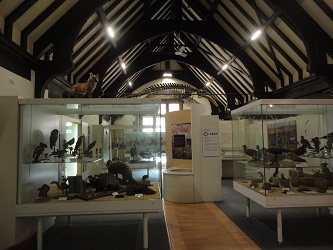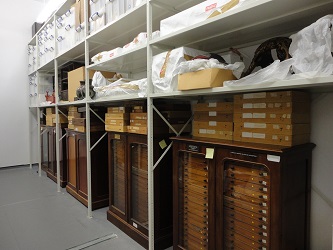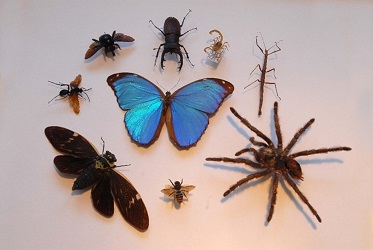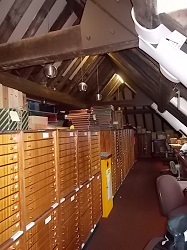Museum Name – Maidstone Museum
Title of Project – Collections Review of Natural History
From – June 2013 – April 2014
Overall Cost of Project £2,000
Funding – Museum Development Micro-Consultancy programme supported by Arts Council England
Maidstone Museum has a varied and significant collection of around 600,000 objects and specimens, including Japanese fine art, carriages, archaeology, regimental collections, Egyptology, costume and natural history.
The review of the Natural History Collections was intended as a starting point to inform future work on the entomology and natural history library collections through partnerships, funding applications, projects and volunteer recruitment.
With such diverse collections, coupled with the reduction in Natural History specialist staff within the sector, the opportunity to engage with natural history specialists couldn’t be missed.
It helped increase our understanding of the collections’ management needs, and, in the process, identify ways to increase their use and accessibility.

Maidstone Museum Kent Wildlife Gallery
The project also enabled us to gain an external specialist’s perspective (the type of audience which has historically used the collection) on our vast insect and library collections.
We worked with two academics, Dr Georges Dussart, Emeritus Professor from Canterbury Christchurch, and Dr Mike Nicholls, semi-retired senior lecturer at Christchurch & Greenwich, both previously unassociated academics who proved to be great connections.
Project outcomes
– identifying how external researchers may use the collections.
– identifying how to enable researchers to access the collections more easily
– identifying the strengths and weaknesses of the collection itself.
The project also highlighted issues with the historic curation and documentation of the collections.
Linking original contextual paperwork back with its associated collection greatly increased our understanding of distinct individual’s collections, as well as posing some very pertinent questions relating to our collecting policy.

Part of Entomology, new environmentally controlled location
This in turn helped us to look at the collection in a different way, identifying areas for action as well as where we needed specialist knowledge to help with the documentation, care of and access to the collections.
As well as understanding the significance of the collections more fully, the report produced included a brief recommendation for the rationalisation of specimens which were in the poorest condition (affected by a fire in the 1970s) or duplicated.
We will need to carry out additional research before such recommendations can be taken forward.
Many benefits
As part of the project, we have been able to move the insect collections to a new environmentally controlled storage area, improving their storage conditions, and providing a much more accessible space for staff, researchers and visitors on guided tours.

Part of the extensive insect collection
The old storage area has since been converted to new staff offices on site at the museum.
This has not only reduced overheads, as the old offices were in an external building, but also brought staff closer to the collections, exhibitions and visitors we work with.
Issues raised
The only negative was that the project timescale was too short and the scope relatively small; if we had thought ‘bigger’, we could have applied for a larger amount of money.
We would have liked to have been able to cover more of the collection, and taken advantage of the specialist knowledge that our consultants brought to the project, particularly the books and research materials.
It would also have been beneficial to have covered other elements of the natural history collections, such as botany, taxidermy, paleontology and geology.
It is hoped that these will be covered in future projects which could in turn enable us to engage other specialists and build new partnerships, learning from the success of this review. However, as a pilot project, it was a success.
Learning
My advice having carried out this project, is to be realistic with the timescale and size of the project.
Do you want the consultant to create an overview position statement so that you can then apply for extra funding to carry out the suggestions?
Or would you like them to concentrate on a very specific section if you are already certain of the issues which require action?

Insect room before reworking of the space
It’s vital to schedule in enough staff time to support the consultants and to make all the collections, information and existing knowledge relating to them accessible.
This ensures that the specialists don’t simply tell you what you already know. Making the most of the consultants’ specialist expertise is vital; they may be able to give additional outcomes that you hadn’t planned for which can be equally important.
In our case this included identifying researchers and specialists who may be interested in the collections as well as museums/institutions with similar collections and biographical information about collectors.
Improving accessibility
The collection specialists and the museum team also discussed new and exciting ways in which access to the collection can be improved and we hope to make it easier for researchers and amateur collectors to come and use the collections more fully.
The project has also highlighted institutions who may wish to work with us and our collections such as local Higher Education institutions (University of Kent, Canterbury Christ Church University, University of Greenwich at Medway, Hadlow College of HE/FE) and we hope to encourage the use of the collections by undergraduates undertaking research for final year dissertations and postgraduates so that they can capitalise on local resources.
The project has also spurred us on to seek further specialist advice on the unaccessioned research library, retaining those books which are current or scientifically useful to staff and researchers, and investigating the transfer of insignificant and duplicated materials to other educational or academic institutions.

New office in old storage space
Instead of shrinking the natural history collections, one of the main recommendations was to expand their use.
We hope to use natural history volunteers to assist with digitising the collection thereby raising its profile and making the records accessible to view online.
This work is underway, reviewing and documenting the 250,000 specimens more fully, and eventually enabling online access to the CMS through the museum website.
We are also identifying other potential uses of the collections with the museum’s education team, highlighting specimens for use in school sessions/workshops with National Curriculum links.
We intend to use the project as a means of supporting future projects and funding applications, as well as to develop future partnerships to raise the profile and use of the collections by both specialists and non-specialists in creative and exciting new ways.
Back to top




